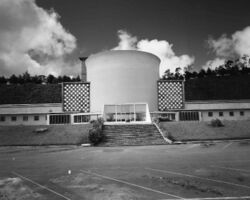Physics:RV-1 nuclear reactor
| RV-1 | |
|---|---|
 Façade of the RV-1 Nuclear Reactor facility in the Venezuelan Institute for Scientific Research (IVIC) | |
| Reactor concept | Pool-type |
| Status | Dismantled |
| Location | Venezuela |
| Coordinates | [ ⚑ ] 10°23′51″N 66°59′03″W / 10.3975°N 66.98417°W |
| Main parameters of the reactor core | |
| Fuel (fissile material) | 235U |
| Primary moderator | Light water |
| Primary coolant | Water |
| Reactor usage | |
| Primary use | Research |
| Power (thermal) | 3 MW |
| Criticality (date) | 12 July 1960 |
| Operator/owner | IVIC |
The RV-1 nuclear reactor, now repurposed and known as Gamma rays sterilization plant ('Pegamma'; Spanish: Planta de Esterilización por Rayos Gamma),[1] is a facility located in Altos Mirandinos, Miranda, Venezuela.[1] It was the only nuclear reactor in Venezuela and one of the first reactors in Latin America.[2][3][lower-alpha 1] Currently, it is used as a gamma ray facility for microbiological sterilization of surgical supplies, packaging, medicine and dry food.[4]
Characteristics
The RV-1 was a pool-type material testing reactor (MTR) with a capacity of 3 megawatts of thermal power. It contained 20% enriched uranium as core fuel and used light water as both coolant and neutron moderator.[5]
History
During the regime of president Marcos Pérez Jiménez, Venezuela became member of the International Atomic Energy Agency after purchasing the RV-1 reactor from General Electric in 1956.[6][7] The project was supported by the administration of United States President Dwight D. Eisenhower, to help promote the Atoms for Peace program,[8][9] with the United States donating United States dollar 300,000 for the construction of the reactor.[9] The reactor was constructed in the grounds of the Venezuelan Institute of Neurology and Brain Research (IVNIC, now known as IVIC - Venezuelan Institute for Scientific Research) under the supervision of Humberto Fernández-Morán; he never saw the project finished, as he went into exile after the Pérez Jiménez regime fell in 1958.[6]
The reactor reached criticality in 1960 and was used for several decades to perform physics research, radiochemistry, production of radioisotopes and as neutron source.[5] RV-1 was last operated in March 1991 and the decision to permanently shutdown the reactor was made in 1997.[5] The core was later dismantled and sent back to the United States.[8]
Repurposing and cancelled sequels
The Venezuelan government approved 2.1 million dollars to repurpose the reactor in 2010.[1] Under the name 'Pegamma',[1] IVIC received the authorization in 2004 to use the renewed reactor facility as an industrial irradiation plant, with a cobalt-60 gamma rays source with a capacity of 1 megacurie.[4][8]
Venezuela later announced plans to build a nuclear power station in 2010.[10] The government signed an agreement with Russia for the purchase and installation of two new nuclear reactors,[8] but after the 2011 Fukushima Daiichi nuclear disaster in Japan, President Hugo Chávez announced a halt to plans on building a nuclear power plant.[8][11]
See also
- Nuclear energy in Venezuela
Notes
- ↑ According to the IVIC,[2] RV-1 was the first nuclear reactor in Latin America, other sources consider RA-1 Enrico Fermi (criticality in 1958) in Argentina as such.[3] Consider also Brazilian IEA-R1 (pt) (criticality in 1957).
References
- ↑ 1.0 1.1 1.2 1.3 "Pegamma" (in es). http://www.ivic.gob.ve/es/matematicas/563-investigacion/unidades-de-apoyo-a-la-investigacion/pegamma.
- ↑ 2.0 2.1 "Inauguración Reactor RV1" (in es). http://eventos-uegf.ivic.gob.ve/es/actualidad-6/galerias-60-aniversario/898-ivic/60-aniversario/3050-inauguracion-reactor-rv1.
- ↑ 3.0 3.1 Álvarez-Cornett, José (21 November 2015) (in es). Guillermo, mi tutor (1 ed.). Caracas. pp. 42. http://chegoyo.com/wp-content/uploads/2015/11/Guillermo-mi-tutor-V1.0-21092015i.pdf. Retrieved 20 June 2019.
- ↑ 4.0 4.1 "Venezuela puts nuclear over oil". 11 November 2019. http://www.world-nuclear-news.org/NN_Venezuelas_puts_nuclear_over_oil_1111101.html.
- ↑ 5.0 5.1 5.2 Traversa, P.; Parra, R.E. (2009). "Venezuelan experience on return of MTR spent fuel from the RV-1 research reactor to the United States of America". Return of Research Reactor Spent Fuelto the Country of Origin:Requirements for Technical and Administrative Preparations andNational Experiences, Proceedings of a technical meetingheld in Vienna, August 28–31, 2006. International Atomic Energy Agency. pp. 195–219. ISBN 978-92-0-151009-9. https://www-pub.iaea.org/MTCD/Publications/PDF/TE_1593_Web.pdf.
- ↑ 6.0 6.1 Squassoni, Sharon; Gerami, Nima (18 September 2008). "Venezuela: A Nuclear Profile". https://carnegieendowment.org/2008/12/18/venezuela-nuclear-profile-pub-22568.
- ↑ Diehl, Sarah (7 May 2019). "Venezuela's Search for Nuclear Power - or Nuclear Prestige". https://www.nti.org/analysis/articles/venezuelas-search-nuclear-power/.
- ↑ 8.0 8.1 8.2 8.3 8.4 Greaves, Eduardo D.; Sajo-Bohus, Laszlo (2017). "26.23 Venezuela". in Dolan, Thomas J.. Molten Salt Reactors and Thorium Energy. Woodhead Publishing, Elsevier. pp. 765–773. ISBN 978-0-08-101243-7.
- ↑ 9.0 9.1 Sánchez Silva, Daniel J. (2016). "El programa Átomos para la Paz en Venezuela" (in es). Revista de la Sociedad Venezolana de Historia de la Medicina 65 (2). http://revista.svhm.org.ve/ediciones/2016/2/art-8/.
- ↑ Harding, Luke (15 October 2010). "Russia and Venezuela strike nuclear power station deal". The Guardian. ISSN 0261-3077. https://www.theguardian.com/world/2010/oct/15/venezuela-nuclear-power-station-russia.
- ↑ Rodríguez Pons, Corina (16 March 2011). "Chavez Halts Venezuela Nuclear Plans After Japanese Crisis". Bloomberg. https://www.bloomberg.com/news/articles/2011-03-16/chavez-halts-venezuela-nuclear-plans-after-japanese-crisis.
External links
- Traversa V, Paolo (1993). "Reactor nuclear RV-1 Manual de utilización" (in es). Instituto Venezolano de Investigaciones Cientificas (IVIC). https://inis.iaea.org/collection/NCLCollectionStore/_Public/31/037/31037749.pdf?r=1&r=1.
- Traversa V, Paolo (1993). "Reactor nuclear RV-1 Planificación (Descripción)" (in es). Instituto Venezolano de Investigaciones Cientificas (IVIC). https://inis.iaea.org/collection/NCLCollectionStore/_Public/31/034/31034642.pdf?r=1&r=1.
- "Reorganización y redimensionamiento de las actividades nucleares en Venezuela" (in es). Sociedad Nuclear en Venezuela. February 1984. https://inis.iaea.org/collection/NCLCollectionStore/_Public/16/051/16051320.pdf?r=1&r=1.
 |

